Phone:
(701)814-6992
Physical address:
6296 Donnelly Plaza
Ratkeville, Bahamas.

Since welding involves high temperatures, arcs of sparks, and molten metal, it is crucial that you use good quality welding gloves to minimize all these risks.
You also need to ensure that the gloves fit your hands properly so that you can have a good grip on the tools and materials. If you have small hands, you need to look for the best welding gloves for small hands.
Checking out reviews of the top products on the market is one of the best ways to identify the highest quality gloves.
This will assist you in gaining a better understanding of each product’s specs, advantages, and disadvantages. You can then determine which gloves are most suitable for your needs.
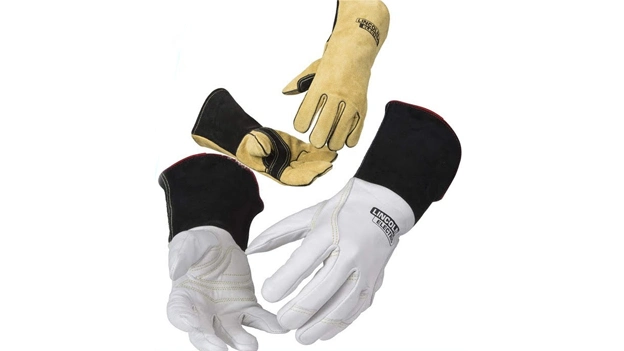
There are a variety of gloves available for welding, each designed for a specific type of welding. Here is a short overview of the most common types of welding gloves:
1. MIG Welding Gloves: These gloves are made from split cowhide leather and are usually lined with Kevlar or Nomex. They have a prominent index finger and thumb pad to help with grip and trigger control.
The palms and fingers of this type of welding glove set are reinforced to protect against heat and sparks. They typically have a cuff extending beyond the wrist to provide additional protection.
2. TIG Welding Gloves: These types of welding gloves are made from kidskin, deerskin, or goatskin for dexterity and comfort. They often have Kevlar threading to help protect the seam from sparks.
They are designed to provide finger sensitivity with adequate protection. TIG welding gloves typically have an extended cuff to protect the wrist and hand from sparks.
3. Stick Welding Gloves: The material used in stick welding gloves is thicker and more durable than that used in other types of gloves. This is because they need to be able to withstand the high temperatures created by stick welding.
The stick welding glove set features reinforced palms and fingers to protect the hands from sparks and hot metal. Stick welding gloves often have a longer cuff to protect the arms from heat and UV rays.
While stick welding gloves are not suitable for all types of welding, they can provide an important level of protection for those who use them.
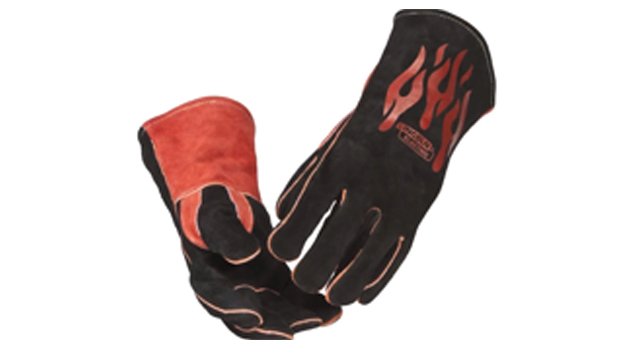
While welding gloves are designed for specific types of welding, you can also find an all-purpose welding glove set that can be used in various welding applications.
When working with different types of welding, such as MIG, TIG, and stick welding, flux-core welding, you may find it helpful to keep a pair of all-purpose gloves on hand. This will enable you to be prepared for any welding task.
If you are interested in welding gloves that can be used for most types of welding applications, you may wish to check out these two options:
Highlighted Features:
About the Product:
These welding gloves that WZQH offers to you are well-made. 1.2mm thick genuine cowhide split leather is used as the outermost layer.
During the process of forming the intermediate layer, air-isolated aluminum foil is used as well as flame retardant cotton cloth, which is used in conjunction with the aluminum foil.
In the inner layer, there is a soft insulating cotton lining made of 100% cotton. Despite the most hazardous conditions, your hands will remain safe due to the flame-retardant thread stitching.
With all of this construction, not only will you be able to resist heat, but you will also enjoy comfort and dexterity. Wear, puncture, cut, and oil resistance are characteristics of these gloves.
You can work confidently with this glove set since it protects your hands from temperatures up to 932°F. This product measures 14 inches in length and is suitable for most small hands.
Reasons That May Attract You:
These heat-resistant welding gloves provide excellent protection even in extreme environments, protecting your hands and forearms from welding sparks, open flames, hot coals, and sharp objects.
With double leather stitching and high-strength sewing on the palm, this glove set is built to last. This pair of gloves has a comfortable fit and is easy to move in.
Due to their advanced heat and cold resistance, these gloves can be used in a variety of settings, including welding, barbecue, gardening, and more.
The gloves are also sweat-absorbent and breathable, which means that your hands will remain dry and comfortable even when working in hot environments.
They are also allergy-free and safe for people with sensitive skin. It is possible to use these gloves for Stick welding (SMAW), Mig welding (GMAW), Flux-Core welding (FCAW), and other welding applications.
Highlighted Features:
About the Product:
This welding glove set from Dewalt features 100% Grade-A buffalo leather for maximum abrasion resistance and durability.
The gloves also feature Kevlar stitching, which makes them incredibly strong and resistant to abrasion and wear. They are available in a combination of black and yellow, making them easy to identify and highly visible in low-light conditions.
Reasons That May Attract You:
The Dewalt premium MIG welding gloves are made from fire-resistant materials that protect from open flames, sparks, slag, and spall.
With this protection, you can confidently weld without worrying about potential injuries. With an ergonomic fit, these gloves provide maximum comfort and allow you to work for extended periods.
Designed in a gauntlet style, this glove set can be worn over fire-resistant sleeves and jackets, and their open cuffs make them easy to put on and take off. Knuckle and finger guards protect your hands from impact, and they do not burn or melt when welding.
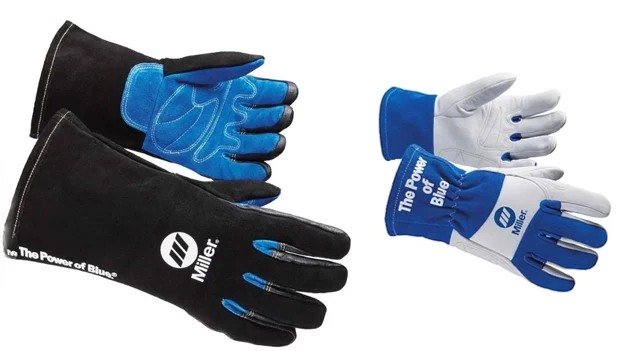
The main thing that sets MIG welding gloves apart from TIG welding gloves is the level of dexterity and protection they offer. MIG gloves are typically more protective as they need to withstand more heat and sparks.
TIG gloves are more flexible and offer more dexterity, as they require a higher level of control when welding. Since TIG welding uses an electric arc to generate heat.
The arc is between a non-consumable electrode and the workpiece. This heats up the workpiece, which melts the metal and joins it together. For this reason, TIG gloves focus a lot on finger protection and dexterity.
In general, TIG gloves are puncture and abrasion-resistant and help protect your hands while welding. The TIG glove also provides full protection to your fingers, hands, and wrists against heat, sparks, and UV rays.
Compared to MIG welding gloves, TIG gloves are primarily constructed of lighter materials.
As MIG welding uses consumable wire electrodes that are connected to a power source, it can produce more sparks and heat than TIG welding.
MIG gloves are typically made of heavier materials such as split leather or Kevlar to protect the hands and fingers from these sparks and heat. The cuffs of MIG gloves are also longer in order to protect the wrists and forearms from sparks.
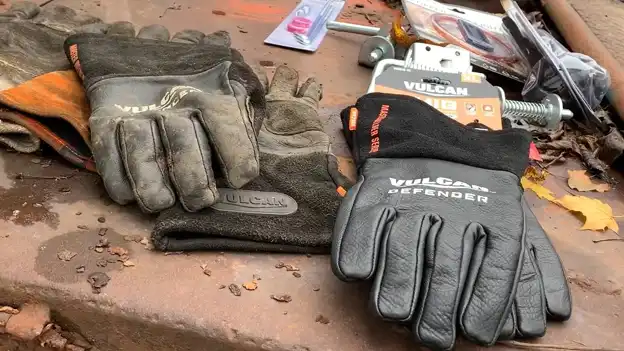
Clearly, MIG welding involves a great deal of heat and sparks. The gloves you wear while performing MIG welding should be able to withstand all of this. You already know that MIG gloves are made of heavy materials, which provides them with an advantage.
It should be noted that not all MIG gloves are the same. There are still some that perform better than others. Let’s take a look at the best MIG welding gloves available on the market.
Highlighted Features:
About the Product:
Revco’s GM1611 welding glove is constructed with premium grain cowhide leather on the palm and split cowhide leather on the back. To ensure maximum durability, the entire garment is stitched with Kevlar.
The gloves are designed to protect the user from heat, sparks, and slag, and are suitable for MIG welding applications. They provide excellent wrist protection due to their 5-inch cuff.
Reasons That May Attract You:
With a soft cotton lining, the gloves are comfortable to wear and less bulky. When you wear these gloves, you will feel a sense of dexterity.
The reinforcement patches provide extra durability in high-wear areas, while the drag and rest patches help to minimize exposure to heat and sparks of the welding process.
You will be able to weld all day long without having to worry about your hands because of the comfortable fit of this glove set. The higher abrasion resistance will also help to prolong the life of the Revco GM1611 MIG welding glove.
Highlighted Features:
About the Product:
These gloves are intended for those who perform MIG welding or fabrication work. The performance boar leather and Durahide technology make them strong and durable while still providing the flexibility and dexterity you need when working with your hands.
DuPont Kevlar fiber is woven into the lining of the gloves to provide cut resistance and protection for the hands when welding.
With its FR cotton lining, it keeps your hands cool while working, while its 5mm heat knuckle insert provides extra protection against heat and sparks.
Reasons That May Attract You:
You can be confident that your hands will be well protected while you are working since they do not dry out or crack when exposed to heat. Keystone thumbs provide superior dexterity and control.
These gloves feature a Gunn Cut design which makes handling heavy materials easier. As these gloves are puncture and laceration resistant, you can work confidently knowing that your hands are protected.
The palm reinforcement ensures that the gloves remain in good condition even after heavy usage. To protect your wrists from sparks and heat, these cut-resistant welding gloves have padded gauntlet cuffs that extend beyond your wrists.
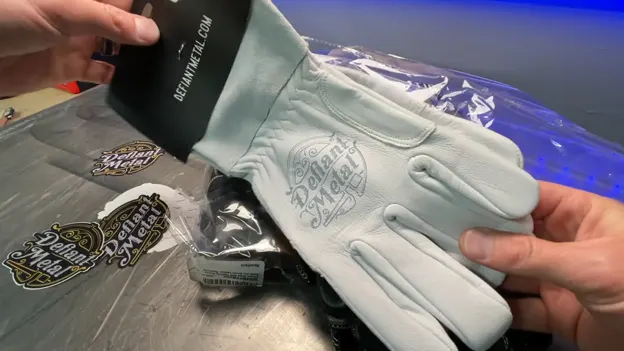
When it comes to TIG welding, you need gloves that will provide you with the dexterity and sensitivity that you need to weld accurately.
At the same time, you also need gloves that will protect your hands from the heat of the welding process. You may check out below for the best TIG welding glove set that will suit your needs.
Highlighted Features:
About the Product:
These gloves have been specifically designed for TIG welding, and offer superior protection. These welding gloves are made of top-grain kidskin, which gives dexterity and comfort.
With Kevlar threading, these gloves help prevent sparks from entering the seam. While welding, this helps to keep your hands safe. An extended cuff ensures that your wrists and hands are protected from sparks and particles.
With a length of 11.375 inches and a width of 4.5 inches, this glove set is suitable for most small hand welders.
Reasons That May Attract You:
These gloves are lightweight and flexible, making them convenient to wear for extended periods of time.
You can rest assured that your hands are protected while working with these gloves since they are resistant to abrasions and punctures.
The straight thumb design of these gloves ensures a superior grip, making it easier to handle your welding torch.
| Product Name | Material | Color | Made Especially For | Cut Resistance | Item Weight |
| WZQH Welding Gloves | Cowhide split leather, aluminum foil, cotton cloth | Black-Gray | Stick welding, Mig welding, Flux-Core welding | Yes | 12.6 ounces |
| Dewalt Welding Gloves | Buffalo leather, Kevlar stitching | Black-Yellow | MIG and TIG | No | 5.6 ounces |
| Revco GM1611 Welding Gloves | Cowhide leather, cotton lining | Tan | MIG Welding | No | 10.5 ounces |
| Mechanix Welding Gloves | Leather, DuPont Kevlar fiber | Black | MIG Welding | Yes | 6.4 ounces |
| IRONCAT 6141 Welding Gloves | Leather | Pearl | TIG Welding | Yes | 4.9 ounces |

When choosing reliable welding gloves for small hands, there are several factors that you need to consider.
This will help to narrow down your choices from the wide range of options that are available. Here are some factors to keep in mind when looking for welding gloves for small hands:
The material of the welding glove set is one of the most important considerations. This is because the material of the gloves determines their ability to resist heat, sparks, and other hazards.
Several factors should be considered when evaluating the material. Check the different parts of the glove set because a high-quality welding glove will use different materials in different parts.
Leather is the best material for the outermost layer. The type of leather used in welding gloves can vary depending on the job.
A glove made of kidskin leather is suitable for TIG welding. Cowhide or buffalo leather gloves can be used for MIG welding.
The intermediate layer of the glove set should also be checked. The material of this layer should be able to insulate your hands from heat. Air-isolated aluminum foil, flame-retardant cotton cloth, or other heat-resistant materials are suitable for this purpose.
In the innermost layer of the gloves, you should choose a material that can absorb sweat and keep your hands dry. Cotton fabric is a suitable material for this purpose.
It is also essential to check the thickness of the material. The thickness will determine how well the gloves protect your hands from heat.
Detailed information regarding the materials used in the various parts of gloves, and their thickness, should be available from the manufacturer. It is also possible to find this information in the product description.
When it comes to welding gloves, size does matter. If the glove set is too big, it can impede your dexterity and make it difficult to hold onto small objects. On the other hand, when the glove set is too small, it can be uncomfortable and leave your hands vulnerable to burns.
So how do you choose the right size welding gloves for small hands? The best way is to measure your palm width, palm length, and overall hand length.
Once you have those numbers, you can consult a sizing chart to find the perfect fit. On the product page or in the product description, you will find information about the product size.
A welding glove’s stitching should also be taken into consideration. The stitching on gloves can affect their durability and how well they provide protection against heat, sparks, and other hazards.
Double-stitched seams are characteristic of the best welding glove set. This type of seam is more durable than a single-stitched seam and is less likely to come apart.
The double-stitched seams are also less likely to leak, which is important for protecting your hands from heat. Stitching materials should also be heat-resistant. This will help to prevent the stitching from melting.

When choosing a welding glove set, ensure the product has a cuff. The cuff of a welding glove serves two primary purposes, which are to protect the wrist from heat and sparks and to provide a comfortable, secure fit.
Welders with small hands should select gloves with a cuff that is not too large or bulky. Otherwise, the glove will be uncomfortable to wear and may impede movement.
The cuff should be made from a heat-resistant material in order to maintain its integrity during extended periods of exposure to high temperatures.
Welding gloves must be able to withstand high temperatures in order to protect the hands from burns.
The level of heat resistance is indicated by the glove’s maximum use temperature. This is the temperature at which the gloves will begin to break down and lose their protective properties.
When choosing welding gloves, make sure to select a product with a maximum use temperature that is high enough to protect your hands from the temperatures that you will be exposed to while welding.
The maximum use temperature for the welding glove set is typically indicated on the product packaging or in the product description. You can also find this information on the manufacturer’s website.
Besides being heat resistant, welding gloves should also be flame, puncture, cut, and abrasion resistant. These properties are important for protecting the hands from sparks, hot metal shards, and other hazards that are common in the welding environment.
Resistance levels are typically stated on the packaging of products or in the descriptions. You may always check the user reviews to find out the opinions of others regarding a product’s resistance.
You need also to consider dexterity when selecting a welding glove set. This is because the gloves need to be able to protect your hands from heat and hazards while also allowing you to have a high level of dexterity so that you can perform your work properly.
For welders with small hands, it is especially important to choose gloves with a high level of dexterity. Otherwise, the gloves can impede your ability to grip small objects or make intricate movements.
For a better understanding of the dexterity of a particular pair of gloves, you may check out the user reviews.
As you will be wearing your welding gloves for long periods of time, it is important to choose a product that is comfortable to wear. This means that the gloves should not be too tight or too loose.
They should also have a soft lining that will not irritate your skin. The gloves should allow your hands to breathe so that they do not get too sweaty.
Check out what others have to say about the comfort of a specific pair of gloves before making your purchase.
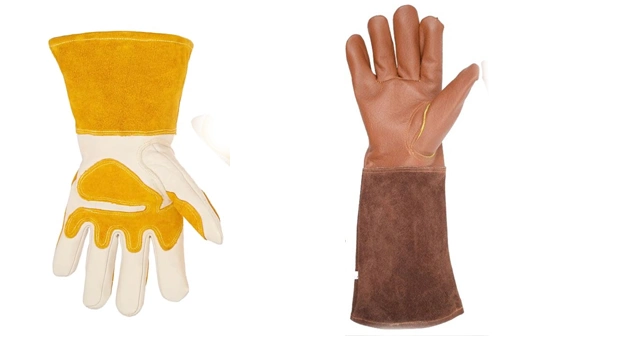
While TIG gloves are not typically used for MIG welding, they can be used in certain circumstances.
TIG gloves are generally thinner and more precise than MIG gloves, making them better suited for tasks that require a higher degree of dexterity. Due to this, TIG gloves may be used for low-power MIG welding or MIG welding on smaller parts.
When welding with MIG, it is recommended to use MIG gloves. Due to the fact that MIG welding uses more heat, you will require gloves that are able to better withstand high temperatures and offer a greater level of protection to your hands.
The gloves used in welding are electrically insulated. This is because they are made of materials that do not conduct electricity, such as leather.
Since welding gloves are intended to provide a high level of protection for your hands, electrical insulation is common.
During welding, the insulation layer prevents electrical shocks from occurring. It is best to avoid direct contact with any electrical current if possible.
Welding gloves do not make your hands colder since they are made from materials that allow your hands to breathe. This prevents your hands from getting sweaty and then cold when you remove the gloves.
The gloves typically have a soft lining that adds extra warmth and comfort. As you wear the gloves, your body heat will also help to keep your hands warm.
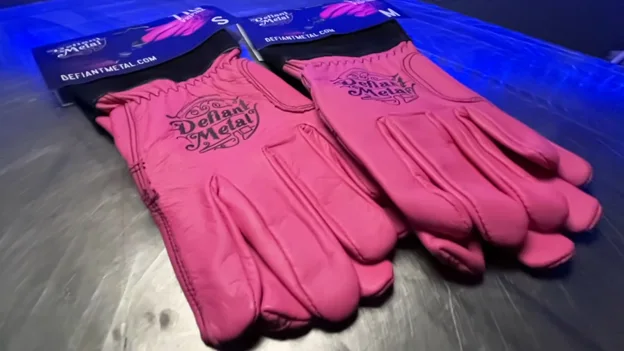
There are several reasons why welding gloves have a cuff. The welding process can produce high levels of radiant heat, which can cause burns even at a distance.
By covering the forearm with a cuff, welders can help to prevent these injuries. Sparks produced by the welding process can also cause burns if they come into contact with exposed skin. Wearing gloves with a cuff can help welders to protect their forearms from potential hazards.
The temperature that welding gloves can withstand varies depending on the type of gloves. Different gloves have different heat-resistant capabilities.
For example, some gloves may only be able to withstand temperatures up to 500 degrees Fahrenheit, whereas others may be able to withstand temperatures as high as 932 degrees Fahrenheit.
Thickness and insulation material used inside a welding glove affect its temperature capability. A thicker glove can withstand a higher temperature.
You should not weld with wet gloves as this can be dangerous. The moisture from the water can cause the gloves to lose their flexibility, which can make them more difficult to use.
When you grab the welding torch with wet gloves, there is a chance of slipping and causing an accident. Most importantly, a wet glove set can increase the risk of electrical shock.
If the gloves are accidentally touched to an exposed wire, the water can conduct electricity and cause serious injuries. For these reasons, it is essential to always use dry gloves when working with any type of electrical equipment.
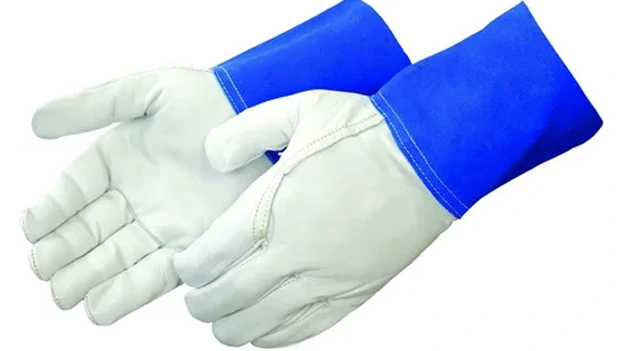
With proper care, a quality pair of welding gloves can last for many months. Several factors can affect the lifespan of your glove set, including the type of leather, the frequency of use, and the level of care.
For instance, gloves made from split cowhide tend to be more durable than those made from deer hide. If you use your gloves regularly, they will inevitably show signs of wear and tear more quickly than if they are only used occasionally.
Taking steps to clean and condition your glove set on a regular basis will help to extend the glove life.
It is not recommended that welding gloves be used to pick up hot metal, as this can scorch the gloves. The heat from the metal can cause the glove material to deteriorate, which will reduce its ability to protect your hands.
In some cases, picking up extremely hot metal with welding gloves can also cause the gloves to catch on fire.
If you must pick up hot metal while wearing gloves, be sure to use gloves that are highly heat and fire-resistant and have a good grip. It is best to avoid picking up hot metal whenever possible.
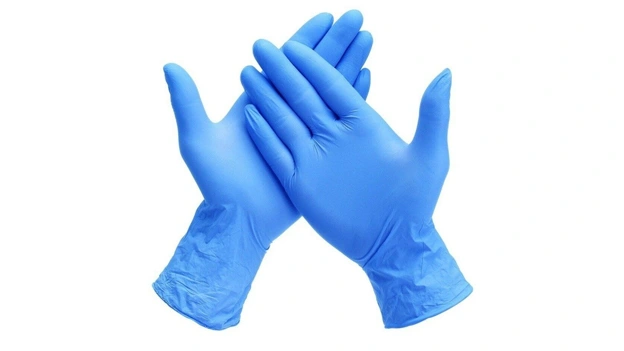
There are a few things you can do to prevent cuts and punctures on gloves. Avoid using your gloves on sharp surfaces that could puncture the material.
If you must work with sharp objects, be sure to wear gloves that are made from thick and cut-resistant materials.
Always use caution when handling sharp objects, and be careful not to catch the gloves on anything that could potentially cause a cut or puncture. Inspect your glove set regularly for any signs of damage, and replace them if necessary.
You now better understand why gloves are necessary when welding, what they offer, and what you should look for when purchasing gloves. Welding gloves protect your hands from burns, cuts, and electrical shocks.
They also help to improve your grip on the welding torch and prevent you from accidentally dropping hot metal.
Compare each glove’s features, pros, and cons to determine the most suitable welding glove set for your needs. Following this, we hope you can pick the best welding gloves for small hands.